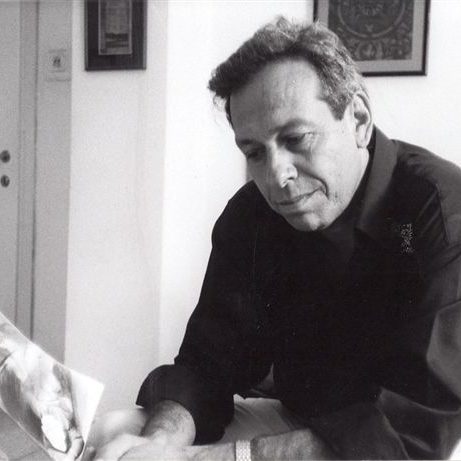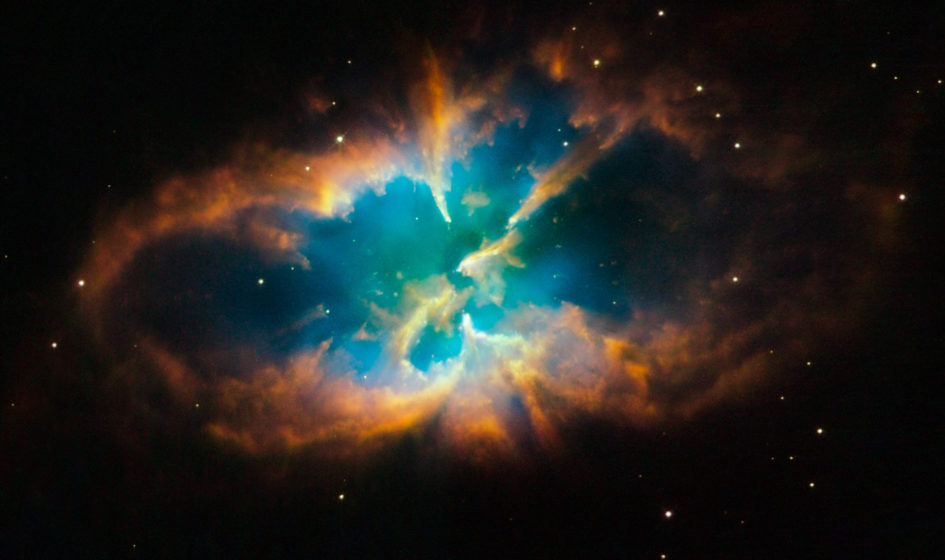Posted in Hebrew on July 25, 2016, by Avi Baumann
"The world exists and is created and formed in each moment, sometimes it is destroyed but also renewed and within it, and from its ashes, the man was created who became an observer, an admirer, a thinker, and a learner, and in the power of man to create his world, to create but also to destroy worlds. And when man learns to create and create, his mind expands, and his world grows, and the more he embraces the world, the more he will know and understand that he and the world are One". (Avi Bauman)
Even though there are many versions of the creation myth, I chose to start with the myth of the Olympic creation, as R. Graves calls it [1]. This myth tells that because initially, there was chaos (a gaping abyss), and from it was born Eros (love), the creator of mating and movement, Gaya, which is the earth, and Tartarus (far west), which is the dark world below. Gaya, the earth, tells us the myth, who had a longing to give birth and to turn from just earth into the great mother, and out of her need for a partner and protector, she connected with Chaos and, with his Eros help gave birth to herself with Uranus, who is the sky and becomes the first father.
Uranus, her son, and Gaya's partner, was initially distant, he looked at her over the high mountains, violated her in his rains, and she gave birth to the plants, trees, animals, and birds. Rivers, lakes, and seas were also added. Over time, Uranus approached her, and every night when they mated, they gave birth to two of the earth and the sky, the first great creatures, the Titans, the multi-handed creatures, and the giant one-eyed cyclopes. The Titans, their twelve children, who were giant creatures, like wild archaic rams, but of human quality, multiplied among themselves. The most famous of the titans were Cronos (time), Rhea (earth), the Smart Titanic Metis (advisor), and the sweet titanic Thetis (editor), Oceanus (fast), and Titan. Ephitus (Protective Force) Using Another Titanic bore Child Prometheus (Forward Thinker The creator of man, his brother Epimetheus (who thinks after the act), Atlas (the dare) and many, many others)
From these titans will be born later the next generation that will later become the Olympian gods, but not before they fight the giants and take their place all this with the help of the great human heroes Hercules. This means that there must already be a man on earth for the gods to become gods.
Lightning from heaven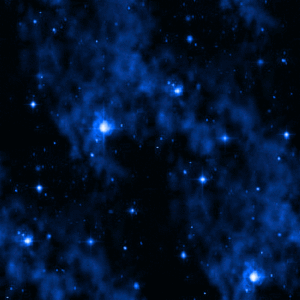
However, it was not long before harmony continued in the New World. Uranus, who had acquired a status that was too large and powerful, saw that his sons, The Cyclops, and even those who were multi-handed were not to his liking; they did not seem to him, and perhaps afraid of them, decided to get rid of them to their grave in the ground, that is, to return them to their mother's stomach. In this cruel act, Uranus insulted Mother Earth and hurt her greatly.
Gaya decided to take revenge on her husband and harm his power and potency. She gathered her titanic children and gave them a large sickle, and asked them to castrate their father when he came at night as usual to sleep with her. Everyone was afraid of their father except for Cronos, her son Titan, who was the only one who dared and even wanted to carry out his mother's plot, of course also out of his interest in defeating his tyrannical father and inheriting his place and bringing about development.
At night, while his parents were lying down, Cronos came and amputated his father's organs and caused that blood, not sperm, to fertilize the mother, the earth, while the father's huge organs fell into the great sea.
cut off his father's organs, causing that blood and not the seed to violate the mother, the earth, while the father's huge organs fell into the great sea. The bloodshed that splashed from this terrifying castration into the earth created the Erinys (the Angry Ones, whose name is Furies in Roman myth) creatures that have become goddesses of revenge who punish those who harm family members and especially those who abuse their parents. Moreover, these streams of blood on earth led to the creation of the giants, monstrous creatures, in which the gods would have to fight to become Olympian gods
But yet, the huge, amputated penis of Uranus that fell into the great sea, fertilized its waters, and out of the foam of the waves was formed, a naked beauty and stunning to all her seers who immediately became the goddess of beauty and love, and her name was Aphrodite (a native of sea foam). This titanic castration of the unbridled celestial paternal power at the beginning of creation has therefore led, albeit painfully, to the formation of the principle of love and erotic connection on the one hand, but on the other hand, also to the birth of the vengeful motif of conscience and the creation of terrible forces, with which man will have to face in order to develop. But this is not yet the end of the first creation story.
The cruelty of the father towards the children of Gaya -The Cyclops and the multi-handed and protracted wars of the next generation, the gods in the other children of Gaya, the giants, created terrifying reactions of revenge of the great mother. The great mother, the earth out of her revenge created in pairing with, the world below, the generation of giant snake-like monsters headed by Typhon (burning wind), Echidna (serpent viper) with offspring The Gorgons (the terrible), Cerberus (the demon in the hole) – the guard dog, Chimera (the monstrous goat) and the like, about which we will hear much more in the stories of mythology.
Thus, dynasties were created in the world, both those of the enlightened constructive good, which in the struggle against evil would later become human and intelligent principles, as well as the infinitely monstrous lineages of evil that would also be part of man's soul and would stand as a challenge of good. Part of human construction will be in this struggle of the evil that stands by and of the good that tries to eradicate it.
It is not for nothing that the peoples of all countries were preoccupied with the question of creation; Both that of the world, of man, and even more than that, a man tried to describe how those gods who rule everything were created. The myth has developed around this great interest in every nation and culture. The myth of creation, which is the unbelievable story above life, tries to create a story about how it all began, who started, and how it was created. The myth of creation tries to give an answer to the question, who are the forces that act for the creation, and who next to them are the forces that hinder or prevent the creation of the miraculous creation: the world and man within it. The stories of these mythologies, then, deal with what was given in advance, who the Creator could also be, what he created and what the process was, and who are the working forces: the maternal and paternal, the feminine and the masculine, which are the good and the bad, and the nature of the whole process.
This myth can indeed be the creation of the world, the gods, man, man and woman, of certain people, or one family or another, or even the person around whom a small story has also been created that will later become a kind of personal myth that is the cornerstone of the personal narrative. The myths of creation, of the beginning, therefore deal with the formation, the sequence of things, and the order of development of the world and man, from the chaotic to the more orderly, from the one-dimensional to the diverse, from the lack of structure to structures with shape, as well as from the primitive to the higher to the human and the struggle between the opposites: the good and the evil, the beast and the human, the father and the mother, the masculine and the feminine and even the human and the human God.
And what about all this and the formation of the psyche? A theory of the mind such as the Jungian one, which sees a parallel between the development of the world and human culture and the psyche of the individual and even claims the existence of these world structures – archetypes within the psyche of man, also refers to such myths as a prototype process that symbolizes the formation of the psyche in its different layers and within it the renewed consciousness of man.
The two creation stories, the Jewish Genesis and the Greek myth, can serve us as two models of creation, creation and formation of both the individual soul and the collective objective in Jung's language. In a monotheistic conception such as the Jewish one, the one, and only Creator is the one who has always been, will always be, and he is with the help of His Spirit that was in everything, created and created. It is eternal, it exists in everything, and at the same time, it acts from the outside.
In contrast to the Jewish conception, according to which the good God in His spirit acts and speaks the act of creation with love, the stories of Greek mythology show a huge creation that is felt humanly as a virtue, as birth and development, starting with the primary materials: the chaos, the Eros and the great mother Gaya, which is the earth itself, continuing with the titanic archaic creatures, born from those primary raw materials, and from there to the gods born as children from them.
Only in reaching the creation of man by the gods and the birth of heroes will we see the power of these beings changing, they form mating and giving birth from a divine superhuman position. The formation in this mythology is, therefore, not in the power of speech, in order and separation, nor an eternal being external to things like God in Jewish creation, but in a kind of developmental act taken from the natural life in which motherhood is primary: desire, mating, birth, and preservation of nature. Fatherhood is the protector that requires power, authority, obedience, and later orders. Creation, formation, and production, according to two such points of view, can have a motive of a predetermined spiritual force, of the use of language, the word of order-making, reason, discernment, and separation and then can be seen as patriarchal, with the Logos controlling its nature. Still, it can no less than that have a motive of desire for mating, motherhood, birth, and development, and then it is matriarchal-feminine and the principle of Eros in its essence.
It follows that the collective psyche [2] that has developed beyond the generations, and at the same time, the soul of the individual undergoing development in his life, can be viewed in these two ways. Jung argues that the earlier and more natural part of our psyche is the collective unconscious, and the deeper we delve into it, the more archaic and chaotic polar structures we will find, and accordingly, the contents will also be amorphous, more irrational, and contrasting like those we found in the ancient myth. It seems that this area of the soul has signs of nature on its entire face, the wild, Ketonic but also the beautiful and the sublime.
In contrast to the ancient and archaic unconscious, whose images are Primordial, the newer and perhaps also renewed part is the I, the ego that is the center of the mind. The self does not exist as a matter of course and although its growth occurs from a natural nucleus that exists in advance, more active action is needed both from the outside, from the human forces that will help it grow, and from the inside, from the totality of the archetype internal forces that pre-exist in the unconscious. The long-awaited self has rational and realistic mental characteristics but also has emotional intelligence and is also the one that can later observe itself and the world and generate new growth. He will also be able to return to the earlier substrate and thus bring about fertilization that will be a creation, rejuvenation, and healing.
The so-called contradiction between the primacy of the Spirit of God that hovers in advance, above and above and created with the word logic and order, and in contrast to the maternal urge for mating, birth and creation should not worry us. There are these and other symbolic forms of creation and forming. Jung argues that the collective self is the primary matrix from which the Self and Ego will be created and emerge like the first person, following which Neumann adds that alongside the layer of the self, the creation and strengthening of the self will arise from the liberation from this matrix that is primal like a great mother.
That is, birth, growth, and independence from it in childhood will help in the creation of the self on the one hand and, later in life, the return to it as a source and expansion of consciousness on the other. Freud, on the other hand, who has a theory of Drives, argues that the Id is the innate primary impulse, and only with the help of the magnifying, rewarding, and frustrating objects will the other components of the psyche be created: the superego and the Ego. According to Freud, this development is the sublimation of instincts, the ability to take materials from the unconscious on one side and ignore them, refining them in an adaptive, conscientious, and rational social way.
In his psychodynamic way, Freud is closer to the rational way of creation that makes an order and brings about overcoming the flood of impulses and drives with the help of the power of the word thought and conscience. On the other hand, Jung and Neumann are closer to the path of developmental and mystical symbolism [3] and, in an essentially more psycho-dramatic approach, describe a human Qazi relationship between the unconscious and the Ego. Starting from a nourishing initial unity, liberation from maternal unity, the war against the dragon, and later in life, the ability to enter and re-mate with the same great mother as mating or rebirth. In both approaches, we will find the conflict, the struggle, and the compromise which result from such difficult creation processes.
Freud refers mainly to the formative parental figures and emphasizes the conflict between the instinctive and intelligent parts, the trauma that has been repressed, and the sublimations and neurotic compromises that will arise along the way. At the same time, Neumann and Jung, whose starting point is the first archetypical parents in combination with the personal ones, will emphasize the archetypal personalization on the uncompromising contrasts, such as the masculine and feminine light and shadow, the transformation, and will indicate the personal complexes that have been produced in each and everyone and the autonomous complexes are like personal monsters with which the person will have to deal later in life.
This first part on creation and the formation of pre-consciousness, that is, before the creation of man with consciousness will be helped by the power of the creation myth in two themes: first, in understanding the process of development of the unconscious itself, in the story of that ancestral layer that existed even before the Ego that is the center of consciousness was created, how it became such a complex matrix with many defined structures. The same layer is the objective psyche with which the baby comes into the world before his personality has developed. Freud tried to free us from the myths and create a rational, scientific explanation [4] for the whole phenomenon of the unconscious-The Id and the development of the Ego from it. The Id is the innate part of the unconscious it is, and only it is -Freud's thesis, neither the superego nor the self is structured with an innate basis.
. It would be interesting precisely to try to link the myth of pre-human creation to the process of formation of the same structure that Freud calls merely Id-instinct-casual without order, as opposed to Jung and Neumann, who see it precisely as the highlight of the overall mental infrastructure for good and bad, the instincts, the mental and the spiritual-together constitute the "self."
Second, we will use the post-human creation myth to understand the way of creation, creation, and development of the Ego, the human consciousness within us, the layer of consciousness that grows and expands like an island out of the sea according to Neumann's image. The stories of mythology will portray the Ego as passive and active in the face of the unconscious, both as material in the hand of the creator or as a hero who fights for his uniqueness and independence but needs the help of the gods who represent the inner forces and his parents and personal towers, who represent the external forces.
The mythological story of the creation of the world with the characters of Eros, Gaya, and Uranus as central ones allows us to see the primary forces in the world and the psyche as impulses of Eros species, motherhood, and fatherhood, creation, and production, but also a struggle of power, of castration, revenge and destruction, and even buds of the creation of conscience, which are given from the very beginning.
The creation story shows us in an archaic pictorial language how these primary forces evolve throughout human history, and we can even deduce from it also about the forces that operate in the individual's developmental history. The mother Gaya, the earth itself, appears to be earlier and more primary than the father and is that of nature, with the impulse of mating and the creation of offspring from within herself and her body.
On the other hand, Father Uranus, the sky above, is created from it in combination with the chaos but gains independence and power, and he becomes the one with the ability to reproductive, to have the power of defense from above, to bring order, selection, and conscience. The primary mother is the matter, the body that is pregnant and giving birth and makes sure that nature continues, while the father, he abounds from above the sky, is the wind and the rainmaker. The myth shows us not only the harmony between them during mating and unity where the work is present but also the attempt to take control of each other, the possibility of harm, the struggle, the recovery, the revenge, and the use of children. We can analyze the myth and understand it on a general human level, as exists in our mental foundation as a repertoire of possibilities with a heavy history. We can also see it in the life of the individual psyche, i.e., the flow of maternal and paternal energy as experienced in our habitat. Celestial harmony is violated when the father gains too much power and begins to distort the good order and possibly cause disharmony that will later lead to development. He does not care about the "natural" flow and the welfare of his children, but only his preferences and the place of his power. The father's attempt to make his order, not to accept what he does not like, to reject, to prefer, and to act from motives alien to ordinary nature, causes disharmony and harm to the mother.
In the stories of the Jewish Bible that do not describe creation from the marital scheme, the problem of God's power is not a problem: he is the only one, there is no one to contradict him or oppose him, and therefore he is the one who can expel from the garden, preferring Abel over Cain and thus fate is determined.
But the Greek prototype is more like the contrasting pairing scheme, and we know that like the imbalance between Uranus and Gaya described in the myth, so too makes one of the common troubles that lead to serious problems at the base of the child's life, an imbalance between paternal and maternal power in the family. We have also seen this in fairy tales [5]. When the mother or father gains too much power, the witch appears or satanic representation. When one of the parents is too weak and lets the other take over, the disaster occurs, and of course, the struggle followed by overcoming that both can also lead to development.
The myth presents the mother as one who goes hand in hand with her children to return to their natural balance. It does so out of harm. The father pushed the unwanted children into her belly and hurt her. But remember that even if the mother's power increases excessively, she may stop nature, run wild and even imprison her children without permission to go out into the world; this is seen in the story of the goddess Demeter – the great mother whose child has no choice but to be kidnapped without her consent.
The story of Uranus's castration by his children reminds us of all of Freud's Totem & Taboo. Freud talks about the killing of the first father, the development of guilt and conscience, and an attempt to recreate the father with the help of a totem. This process is almost the only one in which Freud was willing to admit the existence of a collective psyche [6], even though he did not call it that.
It is interesting to see that even in the myth that I have described, from the castration of the father, the element of guilt is formed. The picturesque figures of the Erinys (the angry ones) are born out of the drops of castration blood that fell to the ground (Gaya). They will appear later in human development as the persecutory archaic maternal conscience, which can bring up psychosis as in the story of the protagonist Orestes after he murdered his mother. Although it is still not the social paternal conscience acquired through identification with the father figure, one that represents a given society-super-ego, an archaic conscience deeply ingrained in an ancient instinctive level and associated with guilt anxiety towards maternal representations. The
mythological description of the three is quite atrocious: they are older than the gods, their hair is snakes, Eisechelos describes them as black-skinned and sometimes turn white, and sometimes Erinys appear with wings and resemble other women's spirits such as those of Harpies.
Their smell was unbearable, their eyes wicked with poison, and their voices examined like the voice of a Bitch. They carry torches and snakes, and their home is underground, and their names also express their essence: one is the "never-ending" Electo, the other Tisiphone "Revenge," and the third Megara "The Rage of Envy". These representations can certainly fit Klein M.'s theory. the representations of the object of the persecuting mother, those that provoke the anxiety of persecutory guilt.
The story of the neutering of the forceful Uranus (Saturn in Roman myth), who decides which of his children will remain and who will not, the father who is afraid of his different, strong, other asymmetrical children (cyclops with one eye and many hands) makes us wonder why Freud did not mention at all the nature of the paternal energy to castrate, kill and reject his children whether out of his fears or preferences.
From this myth, we learn that within the ancestor, there is a fear for his place and power; he is afraid of his children and tends to return them to their mother's belly. But it is possible that also, because of his desire for perfection, symmetry, and familiar patterns, he will reject the difference and the other. This ancient myth describes primordial paternal energy that is almost devoid of humanity. Development is seen in the myth of the sequel, in which the second generation of ancestors was created.
The sequel myth, in which the second generation of ancestors was created, shows an interesting development of Cronos versus Uranus and later of Zeus as more human than Cronus.
Aphrodite 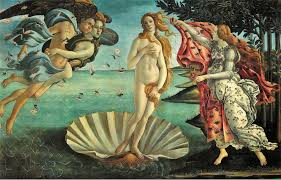
But first, we need to find out another facet of this interesting myth, how the Goddess of beauty and erotic love is created, which will be entrusted with the connection between the sexes, precisely from such a formidable castration. First, it is born from the sea and not from the belly of Mother Earth; it is not related to the primary motherhood of the earth. Rather, it is created from another mother, the sea ocean, which symbolizes the emotional unconscious. It is precisely the pain of renouncing phallic power that gives birth to her. And perhaps the renunciation of the overpowering aggressiveness of instinct is what will lead to the birth of the principle of beauty, love, and relationships. And this is only the beginning because of the goddess Aphrodite; her development and exploits will accompany us later when we talk about the incarnations of love in the story of the heroine Psyche, the human psyche, and her relationship with the goddess.
And let's go back to the initial big mother, Gaya, who is not satisfied with castrating the father, and out of her pain and frustrations with the father, Uranus takes revenge by creating pairings with the world below. Uranus picked her up, but after insulting her, she went downhill. The myth reminds us that the mother not only raises her eyes but that sometimes she will hurt, be offended, and take revenge, become a witch and give birth to evil, the monstrous stopping and the deadly. Even in the third generation of the Olympian gods, this motif still appears when Hera takes revenge on her husband Zeus and creates the monstrous Thiophen herself without Zeus, which she later uses against some of the objects of her jealousy.
The monsters will symbolize the distortions created and subsequently produced from harm, insults, and jealousy that lead to revenge throughout the stories of mythology and in life. In the individual's psyche, such births symbolize the possibility of forming autonomous negative personal complexes [7], which are usually vulnerable. Each monster has a history of being hit or sent by something to hit.
And what happens later in the myth in the Titan's generation?
And what happens in the down world below the surface: the myths of Hecate the Witch, the world of night and death.
The second generation of mythological creatures take on a more human form and are also children, sons, and daughters of the primary father and mother. Titans are scattered across the earth, mostly on the ground, but some in the depths of the sea, such as Oceanus, Thetis and some even below the earth in the depths of the underworld, such as the witch Hecate (100), which represents the dark face of the Great Mother.
They are not gods and will not be like that but represent a further development and more complexity of the primary archaic energies. The successor of Gaya in the motherhood axis is Rhea, the next great mother
and the husband of Titan, who castrated his father Cronus, the father of time who will be the next. The rest of the Titans represent energetic forces from different areas of life that will play roles later in development, the most important of which is Prometheus, the "forward-thinking" Titan that will later play an important role in the creation and development of man and in the development of human consciousness in general.
The primary representations of the mother on its various faces: we knew Gaya, and she is the land, the earth itself, the source of all, and we got to know the Erinys who was born of her and their father's blood and symbolize her persecutory conscientious aspect, but mythology tells us about several other pre-Olympic representations that illustrate to us the power of the mother and her complexity in the creation story as well as in the fate of man. One important group associated with the representations of night and especially the moon and born to their mother tonight were the three Moirés or goddesses of destiny that weaved the thread of life.
Fate was determined at birth, as the Greeks saw it, and we all know that the mother figure is a central part of our destiny. Moirés, the night girls (symbolizing the three parts of the moon, the storm, the full, and the empty), as in many other mythologies, are as women Weaving: One is Clotho, the other is Lexis (which allocates the quantity), and the third is Atropos (the inevitable), the one that cuts the string. All three together as a single unit possess indisputable power. Even Zeus, king of the gods, cannot control their actions.
Demeter 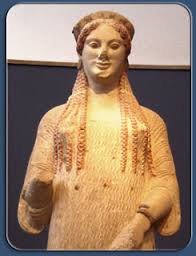
Out of the Night mother were born several more beings that should be mentioned associated with the mother's dark side. Some of them are male and are related to sleep and death, Hesiod's mentions Hypnos as representing sleep and Thanatos as representing death.
Some of them are feminine, including Nemesis – revenge, Gers – old age, and Strife – the quarrel.
But most important of all these is another figure representing the face of the other's otherness. It is Hecate is indeed one of three powerful goddesses associated with the representations of the underworld: Uribe's and Stitches, but the most well-known of them all, especially as the moon goddess Hecate is closer to us and the mythological stories and more tangible as a mother who knows the secrets of the night and the power of the unconscious. She is like a witch who lurks mainly at the crossroads and sees and hears everything. She expresses the fear of the mother who knows secrets, sees and hears everything and is the mother of witches who will later appear in fairy tales.
All the representations of the mother that we have seen so far: the Earth-Gaya-Moirés, the Erinys, and Hecate together express the immense power of the primordial Ktonic mother on its different faces. The second-generation titanic appears mainly as a great mother who helps the reindeer to extricate herself from the great power of Cronus, her husband. At the same time, the goddess Demeter from the third generation and who is already from the age group of the Olympian gods symbolizes the development of motherhood, sowing, growing secrets of wheat, and expanding her functions and the ability for the painful separation from the children. We will see her story later.
The development of the father's archetype through the ancestral figures.
In the various representations of the father, starting from the figure of Uranus, we have seen the motif of power, domination, and anxiety in its place when the sons were born. This motif also appears in the story of Cronus the Titan, who replaced his father, Uranus.
But first, we will mention that there are also created couples without power struggles that continue to enrich the world later in its creation according to Hesiod's Three Titaness took three Titans: Tia took Hyperion and gave birth to him Helios-"The Sun," Silenus "The Moon" and EUs – "The Dawn" while Phebe took Kios and gave birth to Leto who would later become the mother of Apollo & Artemis. But the main story related to the development of the father of fatherhood versus motherhood and his attitude towards children is that of Rhea and her husband, her brother Cronus who gave birth to six children. Three boys and three girls will form the basis of the Olympic Gods in the future. The boys are Poseidon, Hades, Zeus, the little brother, and the girls are Hestia, Demeter, and Hera.
Cronus "The Time", after defeating his father and seizing power, Cronus " The Time " brought order and discipline to the world and even began the development of the oracle that appears as an oak tree.
This father reacts with immense anxiety when his six children are born, who are later supposed to be the main Olympic gods and in the knowledge of the bright future that awaits his children and especially to the young man decides to eliminate them.
Cronus
While Uranus buried some of his children in the earth lining, Cronus pursued a strategy of ingestion. He swallows each child as soon as he is born and keeps them in his belly. This is not an act
that this ancestor uses as a way of maternal domination to swallow the child, not to give him a life of his own. The child surrenders and becomes part of the father is annulled, and cannot live his life.
The beginning of forceful and suffocating patriarchy. The help of the children is enlisted by the great mother Gaia and her husband Uranus, and Zeus, the young man who is supposed to be the father of the gods and the man born in secret, smugglers, and hiders immediately after birth in the Diktis cave on the island of Crete. On her parents' advice, Rhea gives Father Cronus under Zeus a stone wrapped in a diaper which she swallows immediately. The secretly raised Zeus gets the best of all the abundant goat Amalthea breastfeeds him with ram milk while the mythical bee Melissa feeds him with honey.
Zeus, the little brother, grows stronger, and in her cunning waters, his father with a vomiting substance he receives from his mother. He
.
Saturn-
frees his brothers and even the sons of Uranus, the Cyclops, who were imprisoned at the bottom of the earth.
The story of the god Zeus has more human features than the previous ancestors. He possesses a human childhood like that of the Heroes. His story has motifs of the hero growing up in the shadow of danger; he is rescued from the mythological goat mother figure, covered in her skin, turns her horn into the horn of plenty, and receives a mission of heroism and rescue.
Zeus's human story hints at the development of the heroes, most of them his sons from human beings, who will appear later after the creation of man. Psychologically such a father figure symbolizes the importance of the father's archetype in the development of the self and ego of his children. But Zeus still has tough struggles until he comes to control Olympus: He has his life to overcome his father Cronus, to fight Typhon an evil monster created as remembered at the time by the great mother Gaya as well as Zeus with the help of his brothers and sisters after he saved to fight the giants that threaten to eliminate the gods for the future.
The war of the gods against the giants is an all-out war, but it will be able to succeed in some important conditions; firstly, victory will be achieved only with the help of all the gods, that is, Zeus must give birth to a few more gods of the next generation and secondly the battle will be
decided according to the oracle only with the help of a human hero who will appear wearing a lion's robe. This is a long period after the creation of man, the birth of the heroes of the sun, symbolizing the development of human consciousness that overcomes the animal and approaches the sun's consciousness.
For many reasons, the gods need a person to recognize them, worship them and feed them with sacrifices, and glorify them. That is to help them gain the status of gods.
Zeus' need for his son Hercules to be the central Human Hero in the drama of the War of the Gods symbolically illustrates to us the importance of the father for the son and the son for the father's development of consciousness. The father archetype will take on meaning with the birth of the hero son, who symbolizes the developing ego, and the self will receive a great boost if he receives the same recognition from the father who gave birth to him.
Zeus thus symbolizes God, the more developed father of the previous fathers. He is God, the prolific father, who also has the power, the Fertility, and the thunder, but the degree of love for his merciful and compassionate children.
This father, god, creates the next generation of gods with the help of different female characters. Even before his sister Hera, his first wife was Titaness Mathis, the wise counselor, and with her help, he created the goddess Athena. The story of the miraculous birth of Athena comes against the background of Zeus's fears like his ancestors. When he learns of Athena's pregnancy of her mother Metis, Zeus is filled with fears and, like his father is, used the technique of Swallowing with a slight refinement: he swallows his wife while she is still pregnant and continues the pregnancy inside his body, he thinks of a son but inside his body grows a daughter who will be born through his head.
The wise Athena is born to her father out of the head and will indeed become those of a head in the future. The goddess of wisdom and just war.
Zeus's second wife, who will become his legal wife, is his sister Hera, who symbolizes institutionalized marriage. She initially refuses to marry Zeus because she is afraid of losing her power; however, Zeus, like most of the heroes, also uses means of cunning. He disguises himself as the chick of an abandoned bird, taking it between its breasts and its heater and then revealing itself to her as the great Zeus.
Hera, whose entirety is in favor of preserving the existing, does not only symbolize the sometimes-good mother and sometimes the punishing power, but also the jealous woman who is afraid of her husband's betrayals sometimes she is the one who stops and complicates everything that leads to the non-institutionalized development and sometimes helps and protects the unity of the family. With his legal wife Zeus there are many conflicts over his betrayals and the creation of his children from other women.
Zeus gives birth to Hera to only one son, and he is Aries, the god of war. To the instigator, quarrel, and debate whenever possible.
Zeus created and gave birth to Hermes by the Titaness Maya, the messenger of the gods, to the trade, theft, and fortune Hermes.
Mercury 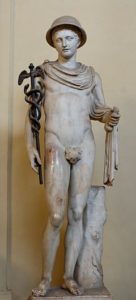
The Apollo god of the sun archers and healing, and his twin sister Artemis Eilat, the hunter, create Zeus with their mother, Leto the Titaness. Apollo becomes the preferred son who continues his father's teachings with all his might.
Artemis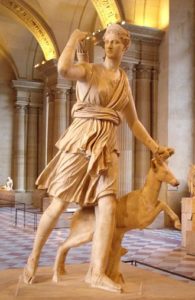
Zeus creates the god Dionysus with a human daughter Smelly. After the latter is burned next to him because of his strength, he swallows her baby, continues the mythical pregnancy, and gives birth to Dionysus out of his shins.
God of Wine- 
.
[1] This myth appears in Theogony, written by farmer Hesiod. Graves R. The Greek Myths 1
[2] A concept coined by Jung represents the collective mental stratum that has emerged throughout human history.
[3] In an article on the mystical person, Neumann defines the developmental process of leaving and returning to the mother as having mystical features. Meeting with numen in unity, separation and return (Eranos)
[4] What do we have and all mysticism and atavistic nonsense (from Neumann's essay on Freud)
[5] Baumann A.-The Golden Hairs of the Breast
[6] Freud, Totem &Taboo (from the Freud Center)
[7] Emotional tone complexes, as Jung calls them, each complex and its emotional tone, anger, sadness, and jealousy, etc.
